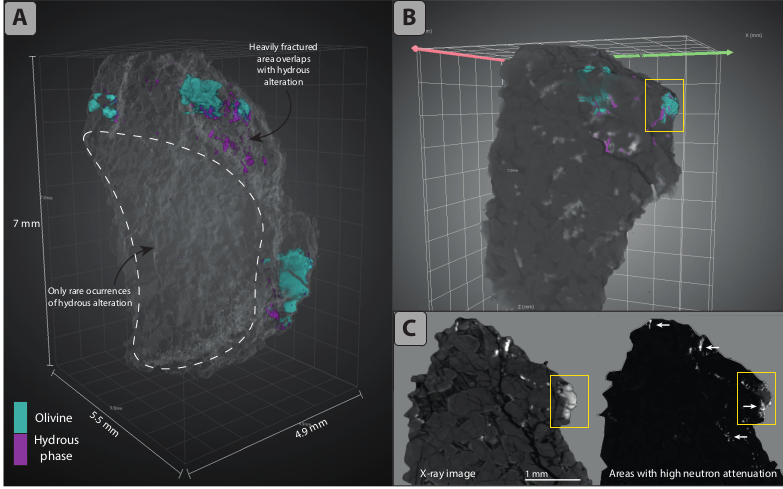Josefin Martell1*, Carl Alwmark1, Luke Daly2,3,4, Stephen Hall5,6, Sanna Alwmark1,7,8, Robin Woracek9, Johan Hektor10,11, Lukas Helfen12, Alessandro Tengattini12,13, Martin Lee2
1Department of Geology, Lund University, Sölvegatan 12, 223 62 Lund, Sweden.
2School of Geographical & Earth Sciences, University of Glasgow, Glasgow, G12 8QQ, UK.
3Australian Centre for Microscopy and Microanalysis, University of Sydney, Sydney 2006, NSW, Australia.
4Department of Materials, University of Oxford, Oxford, OX1 3PH, UK.
5Division of Solid Mechanics, Lund University, Sweden.
6Lund Institute of advanced Neutron and X-ray Science (LINXS), Lund, Sweden.
7Niels Bohr Institute, University of Copenhagen, Copenhagen, Denmark.
8Natural History Museum Denmark, University of Copenhagen, Copenhagen, Denmark.
9European Spallation Source, Lund, Sweden.
10LUNARC, Centre for Scientific and Technical Computing, Lund University, Sweden.
11Department of Materials Science and Applied Mathematics, Malmö University, Sweden.
12Institut Laue-Langevin, Grenoble, France.
13Universite Grenoble Alpes, CNRS, Grenoble INP, 3SR, Grenoble, France
Water is essential to life as we know it. In planetary sciences, it is also considered key to whether life ever existed elsewhere in the Solar System, for example on Mars. One way to approach this question is to investigate martian meteorites that reacted with liquid water when they were still part of the martian crust.
The so-called Miller Range (MIL) 03346 nakhlite is a 715 grams meteorite that was discovered by scientists in the Miller Range mountain in Antarctica in 2003. Nakhlites are a specific class of igneous martian meteorites that were blasted off the Martian surface by an asteroid impact about 11 million years ago, and they have been of particular interest for scientists as they may shed light on Mars’ ancient hydrothermal systems, where hot water was once circulating through the bedrock, see e.g., [1]. These sites are intriguing targets since hydrothermal systems on Earth are known to harbor microbial life.
It was known that this specific meteorite reacted with water about 630 million years ago, when still part of the martian bedrock [2]; the of aim this study was to find out whether the hydrous phases in the MIL 03346 meteorite stem from a large-scale hydrothermal system or another source, such as local sub-surface ice. A sample of the meteorite was investigated – together with traditional microscopy techniques – by combined neutron and x-ray tomography, to non-destructively capture its morphology along with the 3D distribution of hydrous phases.
Neutron tomography was chosen because neutrons are very sensitive to hydrogen, and performed at the NeXT instrument of the Institut Laue-Langevin in Grenoble (France) with a high spatial resolution (pixel size of 7.15 μm). X-ray tomography is commonly used in geology to investigate a specimen’s morphology without damaging it, and complementary x-ray tomography scans were performed with an approximately matching effective pixel size of 9 µm at the 4D imaging laboratory of Lund University.
Some of the results are shown in Fig. 1 as 3D renderings and cross-sectional slices for visualization of the spatial arrangement of the hydrous phases. It highlights that minerals within the meteorite that were altered by liquid water, are concentrated within isolated patches. This pattern suggests that the water responsible for altering these minerals did not leak into the rock from a hydrothermal system. Instead, the water likely came from ice buried within the rock itself that melted due to a meteorite impact. This would suggest that in the particular area where the nakhlite originated from, the conditions were not fruitful (over a sufficiently long time) for life to emerge or develop.
The methodology of using neutron and X-ray tomography is promising for analyzing extraterrestrial rocks. For instance, NASA will bring back samples from the Red Planet with its “Mars 2020” mission, and samples are right now being drilled by the Perseverance rover. These samples are expected to be brought back to Earth around 2030. When dealing with such rare samples, non-destructive analyses are crucial for characterizing samples before continuing with destructive analyses.

Fig.1: Combined x-ray and neutron volume data sets of the martian meteorite MIL 03346,230. Voxel size is 7.15 μm. (A) 3D rendering of the sample, where olivine (based on X-ray volume) and hydrous constituents (based on neutron volume) have been segmented and combined. Other phases are transparent; however, the outline of the sample has been kept for context. (B) The sample was clipped to show part of the interior. The gray background is from the X-ray volume, where the bright mineral corresponds to titanomagnetite; this mineral occurs within the whole sample. The yellow box marks one olivine grain that is also visible in (C). (C) X-ray image and a corresponding slice where areas of high neutron attenuation have been highlighted (also shown with arrows). The yellow boxes correspond to the olivine grain marked in (B). Figure modified from the original publication (see reference below).
[1] A. Udry, G. H. Howarth, C. D. K. Herd, J. M. D. Day, T. J. Lapen, J. Filiberto, What Martian meteorites reveal about the interior and surface of Mars. J. Geophys. Res. Planets 125, e2020JE006523 (2020).
[2] L. Borg, M. J. Drake, A review of meteorite evidence for the timing of magmatism and of surface or near-surface liquid water on Mars. J. Geophys. Res. Planets 110, E12S03 (2005).
Original publication:
The scale of a martian hydrothermal system explored using combined neutron and x-ray tomography, Science Advances 2022, DOI: 10.1126/sciadv.abn3044











